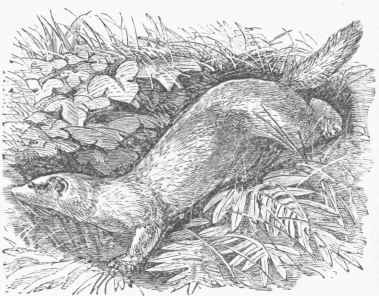Ferret
Description
This section is from "The American Cyclopaedia", by George Ripley And Charles A. Dana. Also available from Amazon: The New American Cyclopędia. 16 volumes complete..
Ferret
Ferret, a carnivorous digitigrade animal, belonging to the weasel family, and the genus putorius (Cuv.). The dentition is: incisors, 6/6; canines, 1-1/1-1; molars, 4/5 4/5, two above and three below being false molars. Since the time of Linnaeus the ferret has been generally considered a southern or albino variety of the polecat (P. fartidus Klein), principally from their producing offspring together; but they may more properly be considered distinct species for the following reasons: the ferret is a native of Africa and warm regions, and only exists in Europe in a domesticated state, being very sensitive to cold, and requiring the protection of man; its size is smaller, its shape more slender, and its snout sharper than inthe polecat; and its habits, though quite as sanguinary, do not enable it to live wild in the woods. The length of the ferret (P. furo, Linn.) is from 12 to 14 in. from nose to base of tail, the latter being about 5 in. long. It is an error to suppose that the ferret is always white, with pink eyes, as such individuals are only albino varieties, such as occur in many other animals; the general color is an irregular mixture of yellow and black, the fur being long and fine, with an undergrowth of cinereous woolly hair; the yellowest animals are most subject to albinism.
Both sexes are alike in color, but the male is the larger, being about 3 in. high at the shoulder and 4 in. at the sacrum. Though ranked as a domesticated animal, and employed by man to hunt rabbits and rats, it is far from docile or gentle, and never seems to have any affection for those who feed and take care of it. According to Strabo, it was introduced from northern Africa into Spain, whence it has spread over Europe. In its natural condition it has the habits of the polecat and weasels, sucking the blood of small quadrupeds and birds, and devouring eggs; it is nocturnal, sleeping nearly all day; in captivity it is fed on bread and milk and raw meat. It produces young twice a year, and from five to eight at a time; gestation is about six weeks, and the young are said by F. Cuvier to be born hairless and with closed eyes, and to be frequently devoured by the mother. Its natural enmity to the rabbit has been taken advantage of by man, who trains it to enter the burrows of these animals, and to drive them out into nets spread over the entrance; the ferret is muzzled to prevent its killing the rabbits, otherwise it is believed it would suck their blood, and go to sleep in the burrow. It will also soon rid a house of rats and mice.
For these reasons the ferret is cared for by man, without whose aid it would not survive in Europe; it is carefully bred in captivity, and sometimes crossed with the polecat, which is supposed to increase its ferocity. The ferret is easily irritated, and then emits a strong disagreeable odor. It is generally believed that the ferrets kill by sucking the blood of their victims, aiming at the jugular vein or the great vessels of the neck; but the rapidity of the death is entirely inconsistent with so long a process as this. Experiments have shown that the ferret often inflicts but a single wound, which is almost instantly fatal, and frequently immediately disengages itself from the body of its victim to attack and kill another in a similar manner; the single wound is in the side of the neck, under or behind the ear, and may or may not pierce the large blood vessels; the canines enter the spinal cord between the skull and the first vertebra of the neck, destroying its victim by the same process as the bull-fighter with his keen sword, or the Spanish executioner with the steel point of the garrote, making neither a lacerated nor a contused wound, but penetrating into the medulla oblongata, the very centre of life, instantly arresting the action of the heart and respiratory muscles, and at once destroying consciousness, sensation, and motion.
This is one of many instances in which the instinct of animals has anticipated the slow deductions of science. The truth seems to be that when the animal is of small size, it is killed by the ferret by wounding the upper part of the spinal cord; but that when it is of superior size and strength, the ferret seizes it wherever it can, producing death by loss of blood, pain, and exhaustion of strength. After the animal is dead, the ferret, like other weasels, no doubt sucks its blood, though the statement generally made in works on natural history, from Buffon to F. Cuvier and Geoffroy Saint-IIilaire, that death is uniformly caused in this manner, is untrue.

Ferret (Putorius furo).
Continue to:


